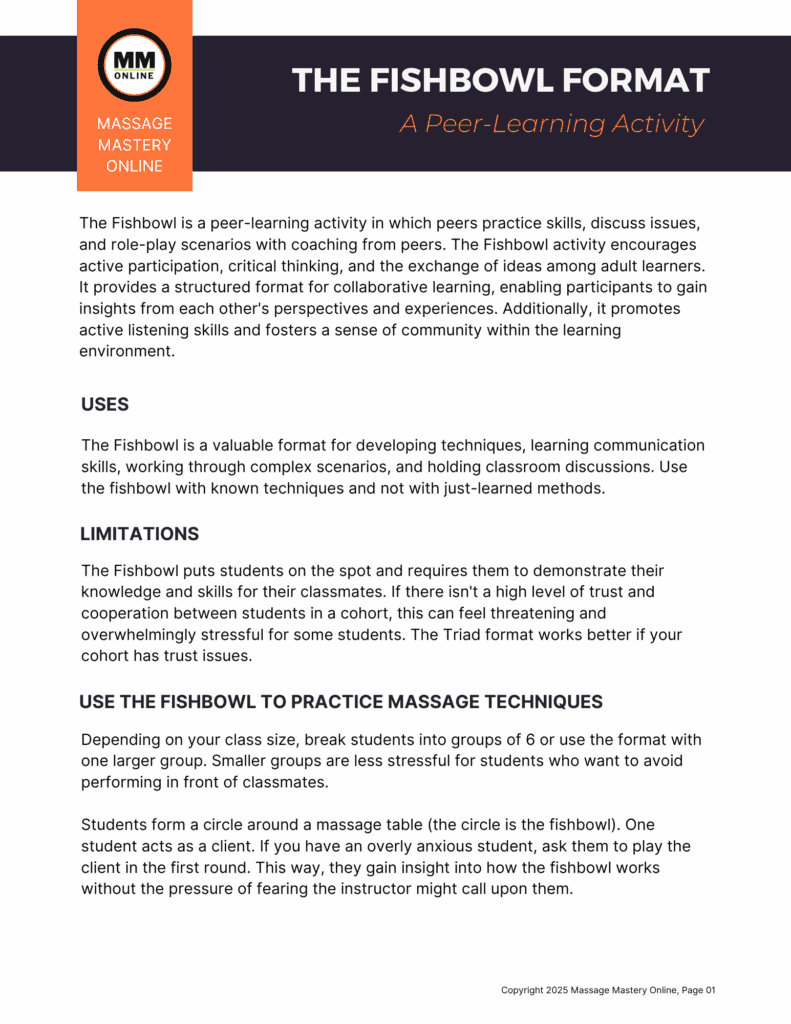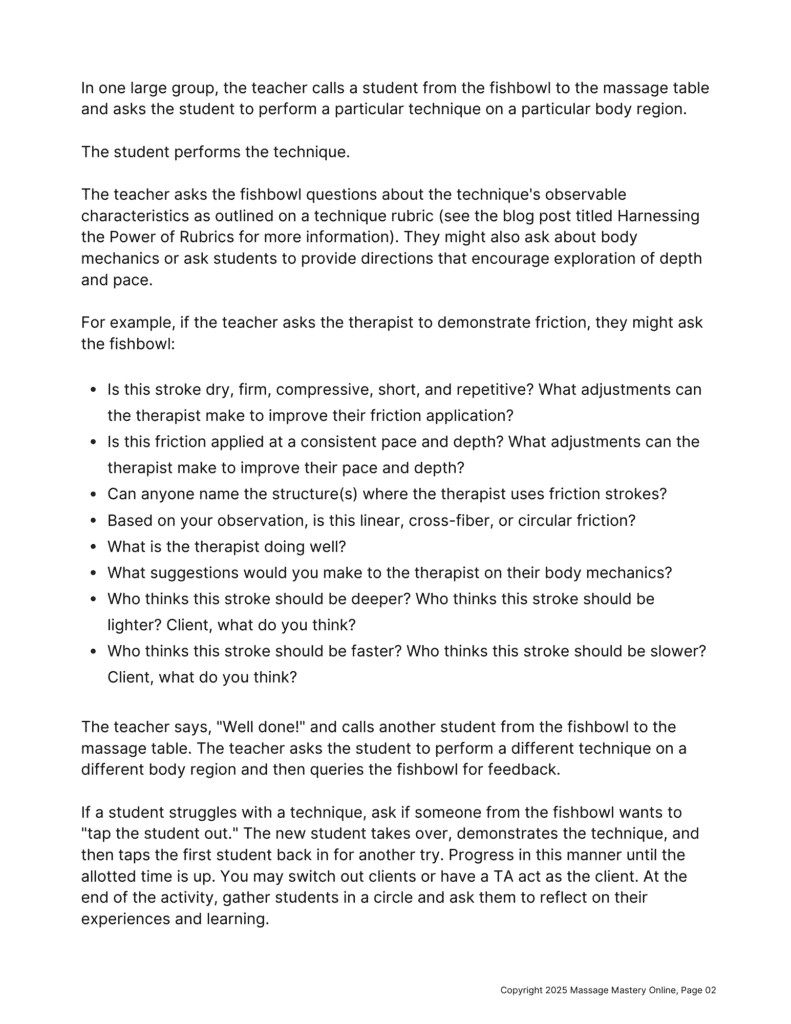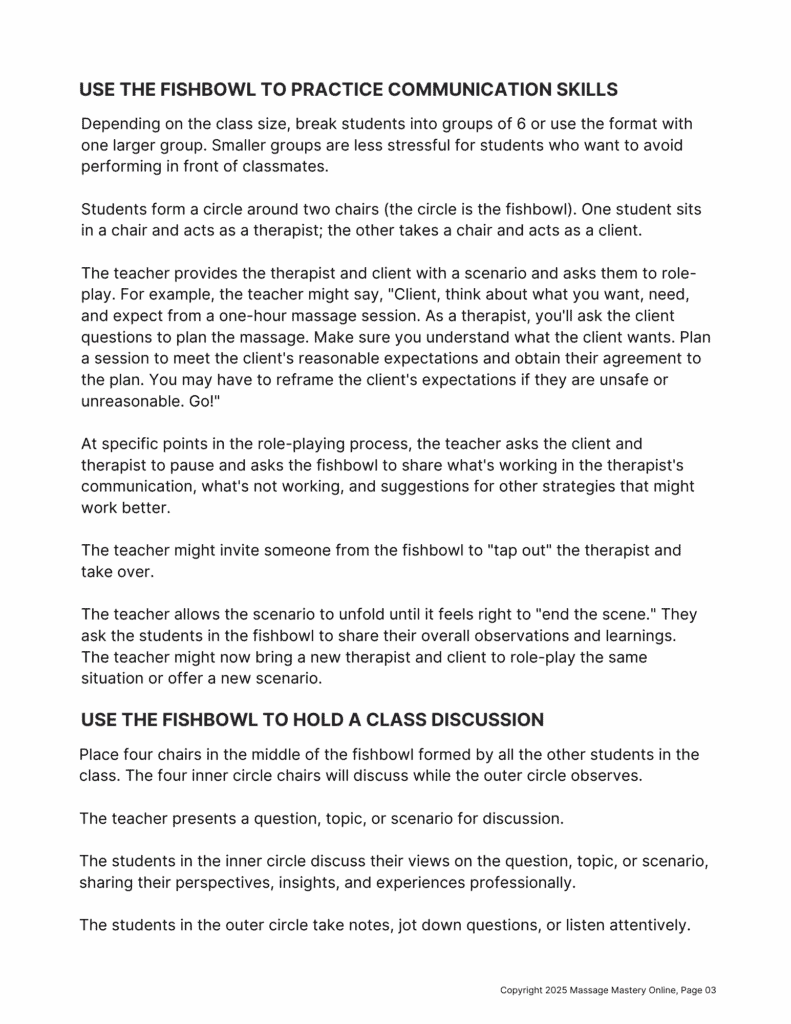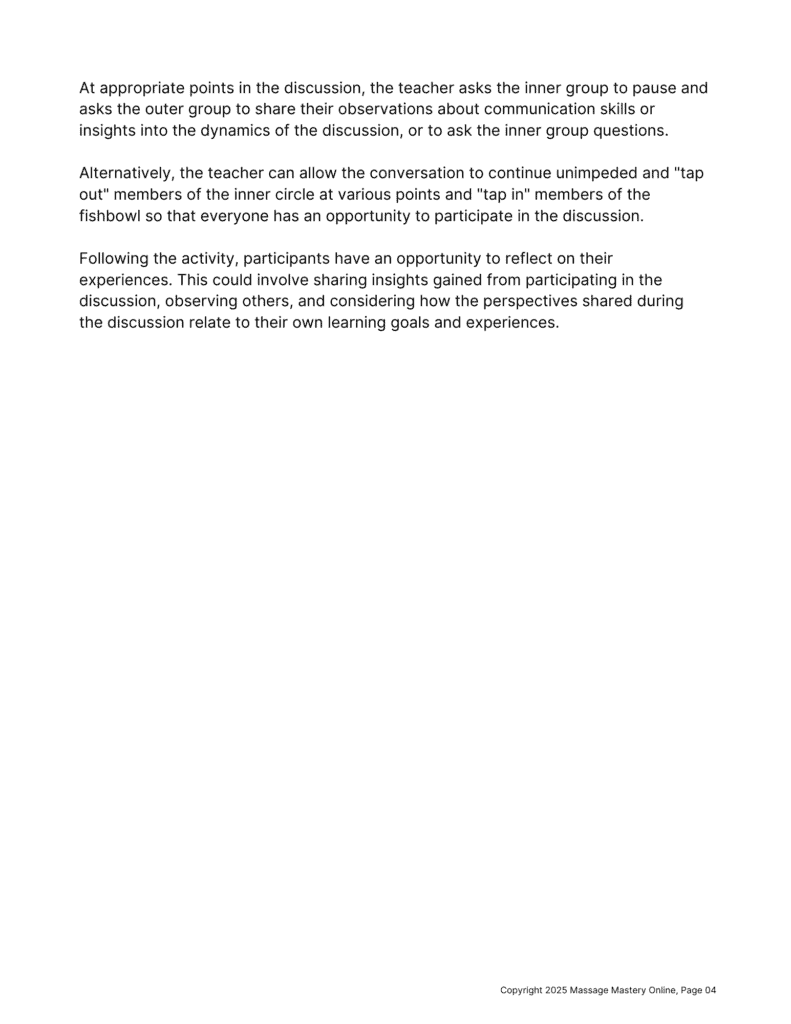The Fishbowl Format: A Peer-Learning Activity
The Fishbowl Format is a peer-learning activity in which peers practice skills, discuss issues, and role-play scenarios with coaching from peers. The Fishbowl activity encourages active participation, critical thinking, and the exchange of ideas among adult learners. It provides a structured format for collaborative learning, enabling participants to gain insights from each other’s perspectives and experiences. Additionally, it promotes active listening skills and fosters a sense of community within the learning environment. Download the directions for this activity at the end of this blog post.
Uses
The Fishbowl is a valuable format for developing techniques, learning communication skills, working through complex scenarios, and holding classroom discussions. Use this format with known theory and skills. This activity is too stressful for students if they don’t have the proper foundation. For example, you wouldn’t use this activity to practice massage techniques students just learned.
Limitations
The Fishbowl Format puts students on the spot and requires them to demonstrate their knowledge and skills for their classmates. If there isn’t a high level of trust and cooperation between students in a cohort, this can feel threatening and overwhelmingly stressful for some students. The Triad Format works better if your cohort has trust issues.
Directions for Using the Fishbowl to Practice Massage Techniques
Depending on your class size, break students into groups of 6 or use the format with one larger group. Smaller groups are less stressful for students who want to avoid performing in front of classmates.
Students form a circle around a massage table (the circle is the fishbowl). One student acts as a client. If you have an overly anxious student, ask them to play the client in the first round. This way, they gain insight into how the fishbowl works without the pressure of fearing the instructor might call upon them.
If you’re in one large group, call a student from the fishbowl to the massage table and asks the student to perform a particular technique on a particular body region.
The student performs the technique.
The teacher asks the fishbowl questions about the technique’s observable characteristics as outlined on a technique rubric (for information about skill rubrics see Harnessing the Power of Rubrics). They might also ask about body mechanics or ask students to provide directions that encourage exploration of depth and pace.
For example, if the teacher asks the therapist to demonstrate friction, they might ask the fishbowl:
- Is this stroke dry, firm, compressive, short, and repetitive? What adjustments can the therapist make to improve their friction application?
- Is this friction applied at a consistent pace and depth? What adjustments can the therapist make to improve their pace and depth?
- Can anyone name the structure(s) where the therapist uses friction strokes?
- Based on your observation, is this linear, cross-fiber, or circular friction?
- What is the therapist doing well?
- What suggestions would you make to the therapist on their body mechanics?
- Who thinks this stroke should be deeper? Who thinks this stroke should be lighter? Client, what do you think?
- Who thinks this stroke should be faster? Who thinks this stroke should be slower? Client, what do you think?
The teacher says, “Well done!” and calls another student from the fishbowl to the massage table. The teacher asks the student to perform a different technique on a different body region and then quarries the fishbowl for feedback.
If a student struggles with a technique, ask if someone from the fishbowl wants to “tap the student out.” The new student takes over, demonstrates the technique, and then taps the first student back in for another try.
Progress in this manner until the allotted time is up. You may switch out clients or have a TA act as the client.
At the end of the activity, gather students in a circle and ask them to reflect on their experiences and learning.
Directions for Using the Fishbowl to Practice Communication Skills or Work Through Scenarios
Depending on the class size, break students into groups of 6 or use the format with one larger group. Smaller groups are less stressful for students who want to avoid performing in front of classmates.
Students form a circle around two chairs (the circle is the fishbowl). One student sits in a chair and acts as a therapist; the other takes a chair and acts as a client.
The teacher provides the therapist and client with a scenario and asks them to role-play. For example, the teacher might say, “Client, think about what you want, need, and expect from a one-hour massage session. Therapist, you’ll ask the client questions to plan the massage. Make sure you understand what the client wants. Plan a session to meet the client’s reasonable expectations and get the client’s agreement to the plan. You may have to reframe the client’s expectations if their expectations are unsafe or unreasonable. Go!”
At specific points in the role-playing process, the teacher asks the client and therapist to pause and asks the fishbowl to share what’s working in the therapist’s communication, what’s not working, and suggestions for other strategies that might work better.
The teacher might invite someone from the fishbowl to “tap out” the therapist and take over.
The teacher allows the scenario to unfold until it feels right to “end the scene.” They ask the students in the fishbowl to share their overall observations and learnings.
The teacher might now bring a new therapist and client to role-play the same situation or offer a new scenario.
Directions for Using the Fishbowl to Hold a Class Discussion
Place four chairs in the middle of the fishbowl formed by all the other students in the class. The four inner circle chairs will discuss while the outer circle observes.
The teacher presents a question, topic, or scenario for discussion.
The students in the inner circle discuss their views on the question, topic, or scenario, sharing their perspectives, insights, and experiences professionally.
The students in the outer circle take notes, jot down questions, or listen attentively.
At appropriate points in the discussion, the teacher asks the inner group to pause and asks the outer group to share their observations about communication skills or insights into the dynamics of the discussion or to ask the inner group questions.
Alternatively, the teacher can allow the conversation to continue unimpeded and “tap out” members of the inner circle at various points and “tap in” members of the fishbowl so that everyone has an opportunity to participate in the discussion.
Following the activity, participants have an opportunity to reflect on their experiences. This could involve sharing insights gained from participating in the discussion, observing others, and considering how the perspectives shared during the discussion relate to their own learning goals and experiences.






